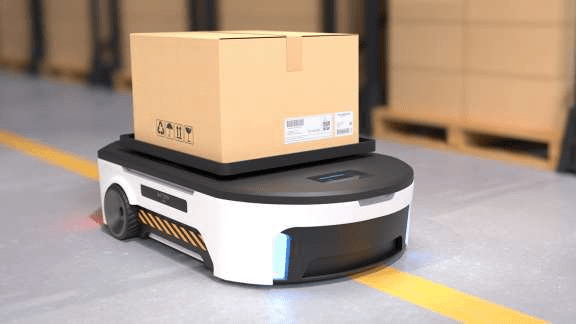Autonomous mobile robots (AMRs) refer to automatic guided vehicles that can perform challenging tasks independently without human control or intervention. They use blueprints, artificial intelligence, sensors, and 3D or 2D vision to navigate an uncontrolled environment with a higher-level understanding. Some of the commonly utilized AMRs include unmanned aerial vehicles (UAVs), self-driving forklifts, inventory robots, etc. They help in conducting mapping, localization, locomotion, navigation, inspection, transportation, and surveillance activities. Autonomous mobile robots are also domestically used for maintenance activities, household cleaning, delivery of goods and services, wastewater treatment, space flight, etc. They offer enhanced scalability, flexibility, safety, etc., and are convenient to deploy. Consequently, autonomous mobile robots find extensive applications in numerous industries, such as media and entertainment, mining, military, consumer electronics, oil and gas, automotive, etc.
What are the growth prospects and trends in the autonomous mobile robots industry?
The expanding retail industry is primarily driving the autonomous mobile robots market. Additionally, the increasing adoption of automated material handling solutions for inventory management is further bolstering the market growth. Besides this, the growing utilization of mobile robots by e-commerce organizations to improve their warehouse operations and optimize product manufacturing processes is acting as another significant growth-inducing factor.
Moreover, the rising terrorist and security threats are propelling the demand for autonomous mobile robots in the defense sector to supply ammunition to soldiers and carry out rescue operations, which is positively influencing the global market. Apart from this, extensive investments in R&D activities are also stimulating the market growth. Furthermore, continuous technological advancements, including the introduction of sensors, are anticipated to fuel the autonomous mobile robots market over the forecasted period.
Autonomous Mobile Robots Market Challenges: –
- Technological constraints and complexity: The creation and application of sophisticated autonomous navigation and perception technologies in mobile robots is challenging and calls for intensive research and development. It can be difficult to overcome technical difficulties including real-time environment sensing, precise mapping, obstacle avoidance, and human engagement.
- Implementation costs: Including the cost of the robots themselves, infrastructure improvements, integration with current systems, and maintenance, the initial cost of implementing AMRs can be rather significant. Small and medium-sized businesses (SMEs) and organisations with tight budgets may find it difficult to employ AMR technology due to cost reasons.
- Safety and regulatory issues: When adopting AMRs in dynamic environments shared with people, safety is a crucial factor. Robust safety features, risk analysis, and adherence to existing laws are necessary to ensure the safety of both the robots and the people around them. It is a continuous endeavour to develop industry standards and recommendations for safe AMR operation.
- Adaptability to a variety of environments: AMRs must be able to function in a variety of contexts, including warehouses, factories, hospitals, retail establishments, and outdoor areas. Each setting has varied difficulties for navigating, handling various things, coping with different surfaces, and cooperating with human workers. It is difficult to create adaptable AMRs that can operate with ease in a variety of scenarios.
- Integration with current systems: Many organisations already have established systems, including enterprise resource planning (ERP) or warehouse management systems (WMS). It can be challenging to integrate AMRs with these pre-existing systems since smooth operations depend on interoperability, data sharing, and synchronisation. Working with legacy systems in particular might present compatibility and integration concerns.
- Impact on the workforce and acceptance: Human workers may be concerned about job displacement or changes in job duties as a result of the introduction of AMRs to the workplace. Businesses must manage the transition well, offer retraining chances, and guarantee that staff members are at ease working with robots. The workforce’s acceptance and collaboration are essential for the successful implementation of AMR.
Autonomous Mobile Robots Market Opportunities: –
- E-commerce and warehouse automation: As e-commerce has grown quickly, there is a greater need for flexible and effective warehouse operations. Order fulfilment, inventory management, and material handling processes can be automated using AMRs, increasing productivity and cutting costs. The opportunity is in offering AMRs with characteristics like high-speed picking, payload capacity, and seamless connection with current warehouse management systems that are specifically targeted to the requirements of e-commerce and warehousing environments.
- Pharmaceuticals and healthcare: The healthcare sector can gain from the usage of AMRs for logistics inside hospitals and clinics, medicine delivery, and inventory management. Workflow optimisation, human error reduction, and patient safety can all be improved by AMRs. The specific needs of patients can be met by creating AMRs with specialised features, like secure medicine storage and real-time tracking.
- Automation in manufacturing and industry: In manufacturing and industrial contexts, AMRs can significantly contribute to the automation of material movement, assembly-line procedures, and quality control. Creating AMRs that can operate in dynamic contexts, cooperate with human workers, and adjust to shifting production demands represents an opportunity. Key factors include the capacity to handle different types of materials and integration with current manufacturing systems.
- Agriculture and farming: By automating processes like crop monitoring, precise spraying, and harvesting, AMRs have the potential to revolutionise the agriculture business. These machines can increase productivity, lessen manual labour, and maximise the use of resources. Opportunities exist for constructing AMRs that can function in a variety of field situations, analysing crops with cutting-edge sensors and imaging technologies, and integrating with farm management systems.

As the editor of the blog, She curate insightful content that sparks curiosity and fosters learning. With a passion for storytelling and a keen eye for detail, she strive to bring diverse perspectives and engaging narratives to readers, ensuring every piece informs, inspires, and enriches.










